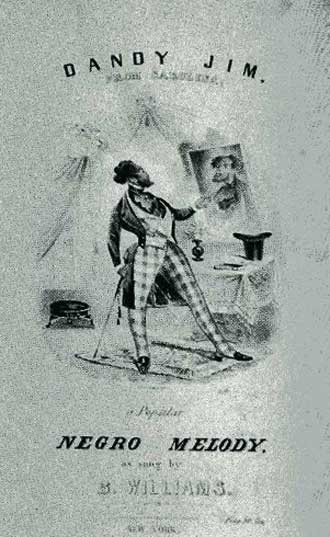Monica L. Miller
Slaves to Fashion: Black Dandyism and the Styling of Black Diasporic Identity
Duke University Press
408 pages, 9 x 6 inches
ISBN 978 0822345855
Slaves to Fashion is a cultural history of the politics of black fashion and dress since the creation of the black diaspora, from the slave trade to the present. Dress has been (and continues to be) one of the most important ways in which we project a sense of self, a class status, and a place on the spectrum of gender identities, sexuality and nationality. This has been the case especially for black people who—though materially deprived in the West throughout history—have made the presentation of their bodies (hair, dress, gesture) a key component and signal of their self-definition and political, social and cultural possibility.
Slaves were dressed by their masters; clothing was used to define black people as subservient. Almost as soon as a slave was issued a piece of clothing, he or she understood that the garment served not only to protect him or her from the elements, but was also part of a power struggle over black identity. Refusing to be defined by others, blacks have countered their representation sartorially, by pointedly playing with their clothing, manipulating it to better express the complexity of who they are.
By examining cultural moments and artifacts that highlight the ability of dress, especially fancy dress, to both dictate and define identity, my book examines this power struggle between masters and slaves, free blacks and whites, upper and working class blacks at key moments and locations in black diasporic history. I look at the ways in which black people, once slaves to fashion, have made fashion their slave.

Blackness is itself a sign of diaspora, of a cosmopolitanism that African subjects did not choose, but from which they necessarily reimagined themselves ... black dandyism is an interpretation and materialization of the complexity of this cosmopolitanism.
Slaves to Fashion began with a footnote I encountered in graduate school. While auditing a class on W.E.B Du Bois’s The Souls of Black Folk, I came across a troubling reference to the fact that the revered Du Bois had been caricatured as a black dandy. In the class, we spent even weeks in detailed analysis of Du Bois’s skill as a rhetorician and lyricist. In order to appreciate the truly interdisciplinary nature of his talents, we took very seriously his training as a philosopher, historian and sociologist. The image of Du Bois that emerged was that of an erudite, punctilious, quintessential “race man.” None of this prepared me for the footnote and accompanying illustration from a political cartoon of Du Bois as a degraded buffoon, overly dressed and poorly comported, whose erudition had been turned into what the cartoon called “ebucation.”
Only when I began to research the history of dandyism and, in particular, the racialization of the dandy figure, did I realize the complex strategy and history behind that caricature. Dandyism has been used by Africans and blacks to project images of themselves as dignified and distinguished, it has also been used by the majority culture (and blacks) to denigrate and ridicule black aspirations. Slaves to Fashion examines the interrelatedness of these impulses and what the deployment of one strategy or the other says about the state of black people and culture at different moments in history.
Although dandyism is often considered a mode of extremely frivolous behavior attentive only to surfaces or facades and a practice of the white, European elite and effete, I argue that it is a creative and subtle mode of critique, regardless of who is deploying it. Though often considered fools, hopelessly caught up in the world of fashion, dandies actually appear in periods of social, political and cultural transition, telling us much about cultural politics through their attitude and appearance. Particularly during times when social mores shift, style and charisma allow these primarily male figures to distinguish themselves when previously established privileges of birth and wealth, or ways of measuring social standing might be absent or uncertain. Style—both sartorial and behavioral— affords dandies the ability and power to set new fashions, to create or imagine worlds more suited to their often avant-garde tastes. Dandyism is thus not just a practice of dress, but also a visible form of investigating and questioning cultural realities.
A quick look at the definition of “fop” and “dandy” in the Oxford English Dictionary articulates a difference between them that is extremely important for considerations of the figure’s racialization. A fop (fifteenth century) is one “foolishly attentive to and vain of his appearance, dress or manners.” But a “dandy” (1780) is defined as one who “studies above everything else to dress elegantly and fashionably.”
Anyone can be in vogue without apparent strategy, but dandies commit to a study of the fashions that define them and an examination of the trends around—which they can continually re-define themselves. Therefore, when racialized, the dandy’s affectations (fancy dress, arch attitude, fey and fierce gesture) signify well beyond obsessive self-fashioning—rather, the figure embodies the importance of the struggle to control representation and self- and cultural-expression.
Manipulations of dress and dandyism have been particularly important modes of self-expression and social commentary for Africans before contact with Europeans and especially afterwards. In fact, in order to endure the attempted erasure or reordering of black identity in the slave trade and its aftermath, those Africans arriving in England, America, or the West Indies had to fashion new identities, to make the most out of the little that they were given. Whether luxury slaves or field hands, their new lives nearly always began with the issuance of new clothes.
Enslaved people, however, frequently modified these garments in order to indicate their own ideas about the relationship between slavery, servitude, and subjectivity. For example, there are documented cases of slaves saving single buttons and ribbons to add to their standard issue coarse clothing, examples of slaves stealing or “borrowing” clothing, especially garments made from fine fabrics, from their masters for special occasions. Slaves created underground second-hand clothing markets in major cities to augment their wardrobes and to exchange clothing that identified them when they wanted to escape. In fact, many slaves “dressed up” or “cross-dressed” literally when they absconded, wearing clothing beyond their station or of the other gender in efforts to appear free and be mobile. The black dandy’s style thus communicates simultaneously self-worth, cultural regard, a knowingness about how blackness is represented and seen. Black dandyism has been an important part of and visualization of the negotiation between slavery and freedom.
In Slaves to Fashion, I wanted in particular to use the black dandy figure to exemplify the inter-relations between racial, gender and sexual identity and the way these categories are always expressed in terms of each other—but with different emphases during different historical periods and geographical locations. In order to illustrate the black dandy’s embodiment of this intersection of identity markers, I consider the pleasures and dangers of the styling of blackness and self-fashioning as well as the performativity, irony, and politics of consumption and consumerism that define such stylization.
The first black dandy in my book, a fabulous black man named Julius Soubise, famous in Enlightenment England for his beautiful dress and outrageous, defiant attitude, often held court in coffee shops that also offered slaves for sale. In this environment, he defied and ironically played with his own former status as a commodity, arriving at these shops in a chaise attended by white footmen, even as his brothers were bought and sold around him. Soubise’s behavior reveals that during that time and forever more, blackness was and is a complicated idea, wholly constructed and always already “performed.”
I argue that blackness is itself a sign of diaspora, of a cosmopolitanism that African subjects did not choose, but from which they necessarily reimagined themselves. In Slaves to Fashion, black dandyism is an interpretation and materialization of the complexity of this cosmopolitanism.
“Dandy Jim, from Carolina.” Published by Firth and Hall, 1843 (New York). Courtesy of the New York Public Library.

In order to illustrate the way that a black dandy can embody complex and even competing notions of blackness, meet “Dandy Jim, from Carolina,” a theatrical figure made famous by nineteenth-century America’s most popular entertainment, blackface minstrelsy. His song in the minstrel show begins:
I’ve often heard it said of late
Dat South Carolina was de state
Whar handsome niggars bound to shine
Like Dandy Jim from Caroline
I went one ebenin to de ball
Wid lips combed out and wool quite tall
De ladies eyes like snowballs shine
On Dandy Jim from Caroline.
Narcissistic to a fault, Dandy Jim was certainly one of those characters whose self-aggrandizing attitude, accompanied by outrageous dress, titillated with equal parts threat and appeal. “Going black” in the blackface minstrel theater means much more than blackening up; the minstrel show was a world in which anxieties about the inter-relation between race, gender, sexuality and class seemingly had free reign.
While largely overshadowed by the character Jim Crow, a denizen of the plantation, the blackface dandy was a particularly potent force in the antebellum minstrel show. In particular, Dandy Jim and his dandy predecessors, Long Tail Blue and Zip Coon, provided a way for working class, immigrant white performers to ask questions plaguing nineteenth-century Americans. What if blacks were free? What if they had money, access to education, unchecked social, cultural, and economic mobility? The blackface black dandy costume, often an elaborate misquotation of elite fancy dress, and pretentious, loud-mouthed, ridiculous (yet funny and provocative) behavior answered these questions, or at least attempted to represent them.
Although the early minstrel show presents the dandy in slightly different guises, what remains constant about its portrayal of blacks in fancy clothing is the figure’s association with sexual threat and class critique. In the case of the blackface dandy, the donning of elite clothing images a desire for social mobility—and for the most extreme form of integration, interracial sex.
What is surprising about blackface dandies is the degree to which they succeed at their plans—for example, when Dandy Jim’s fellow, Long Tail Blue, has his long blue coat split by a watchman in his song, a clear assault on his phallic power, it is very quickly repaired. Even though Long Tail Blue does not complete a conquest of any white “galls” at the end of his song, which is his intention, he is still very much in the chase.
Dandy Jim is involved in similar antics: a narcissist intending to cut a figure at the ball, and, in some versions, woo “lubly Dine” into providing him with “eight or nine/ Young Dandy Jims of Caroline,” Dandy Jim boasts of a sexual prowess that is definitively linked to his appearance as a “handsome nigga [who is] bound to shine.”
Unlike that of Long Tail Blue, Dandy Jim’s lust remains within his own race and social conventions: “Lubly Dine” is a fellow black who Jim actually marries in the song. However, despite the placement of Dandy Jim’s excessive sexuality within an intra-racial family structure, his quest to populate the world with as many little dandies as he can, “ebery little nig she had/ Was de berry image ob de dad,” is nevertheless threatening. The (white) anxiety of black freedom and equality that black dandies embody is not just one in which social equality leads to miscegenation (as in the case of Long Tail Blue) but one which seems to equate miscegenation with the threat of mere black presence and visibility.
Long Tail Blue, Zip Coon, and Dandy Jim menace even as they amuse, revealing the affinity between effeminacy associated with extreme attention to dress and appearance, and a hyper-masculinity linked to a sexual rapacity that exceeds racial boundaries.
Despite the fact that blackface dandy’s sexual threat is almost always figured as heterosexual, the figure has a queer effect because of the way in which his racialization is so bound up in his sexuality and vice versa. This is not to say that the blackface dandy himself is queer; to do so would be anachronistic and to limit, in some ways, the total force of his boundary crossings. Instead, the figure’s excesses allow us to see from a contemporary viewpoint the way in which the minstrel show worked hard to express anxieties about blackness in terms of the other markers of identity and vice versa.
When looking at the show, we forget that the “galls” being pursued here by white men in blackface are themselves white men in blackface and drag. From this perspective, the blackface dandy’s antics signal the intriguing possibility and threat of both interracial and same-sex liaisons that have to be pursued and are often realized through blackness. The blackface minstrel show featuring the black dandy was not, in any way, an arena in which the anxieties attending race, class, sex and gender were contained. In fact, the dandy on stage, a white performer in blackface, often cross-dressing in terms of race, gender and class, comes alive in the pursuit and performance of these anxieties, in the production of a queerness that lingers after the curtain goes down and the burnt cork removed.

Though often considered fools, hopelessly caught up in the world of fashion, dandies actually appear in periods of social, political and cultural transition, telling us much about cultural politics through their attitude and appearance.
While I do not directly investigate contemporary “dress debates” such as Bill Cosby’s call for young black men to hitch up their pants, or what it means for P. Diddy to be nominated for “Designer of the Year” for his Sean Jean line while employing “butler” and stylist Farnsworth Bentley to carry his umbrella in St. Tropez, or even why Andre 3000 of Outkast frequently dons a straw boater in homage to the older black men in his Atlanta neighborhood, it is my hope that the history and case-studies that I do provide in the book give readers a sense of how and why dress matters for black people.
Whether practiced on the streets of metropolitan Europe or America, seen on the colonial or blackface minstrel stage, textually illustrated in novels hoping to define New Negroes and race men, or experienced visually in photographic exhibitions in the galleries of Chelsea and London today, black dandyism is a strategy of survival that has a long and multifaceted history.
Black dandyism is, above all, an investigation of the use and abuse of image. As Iké Udé, an artist/aesthete whose self-portrait is my book’s cover, says, “In the end, a dandy’s style is not just about form and substance. It is also about the luxurious deliberation of intelligence in the face of boundaries.”




We don't put paywalls. We don't distract you with ads. We don't sell your data.
Please help to keep this running!